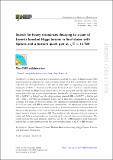| dc.contributor.author | Tumasyan, A. | |
| dc.contributor.author | Adam, W. | |
| dc.contributor.author | Andrejkovic, J. W. | |
| dc.contributor.author | Bergauer, T. | |
| dc.contributor.author | Chatterjee, S. | |
| dc.contributor.author | Damanakis, K. | |
| dc.contributor.author | Dragicevic, M. | |
| dc.contributor.author | Escalante Del Valle, A. | |
| dc.contributor.author | Frühwirth, R. | |
| dc.contributor.author | Jeitler, M. | |
| dc.contributor.author | Krammer, N. | |
| dc.contributor.author | Lechner, L. | |
| dc.contributor.author | Liko, D. | |
| dc.contributor.author | Mikulec, I. | |
| dc.contributor.author | Paulitsch, P. | |
| dc.contributor.author | Pitters, F. M. | |
| dc.date.accessioned | 2022-05-09T18:10:03Z | |
| dc.date.available | 2022-05-09T18:10:03Z | |
| dc.date.issued | 2022-05-02 | |
| dc.identifier.uri | https://hdl.handle.net/1721.1/142419 | |
| dc.description.abstract | Abstract
A search for new heavy resonances decaying to a pair of Higgs bosons (HH) in proton-proton collisions at a center-of-mass energy of 13 TeV is presented. Data were collected with the CMS detector at the LHC in 2016–2018, corresponding to an integrated luminosity of 138 fb−1. Resonances with a mass between 0.8 and 4.5 TeV are considered using events in which one Higgs boson decays into a bottom quark pair and the other into final states with either one or two charged leptons. Specifically, the single-lepton decay channel
HH
→
b
b
¯
WW
∗
→
b
b
¯
ℓ
v
q
q
¯
′
$$ \mathrm{HH}\to \mathrm{b}\overline{\mathrm{b}}{\mathrm{WW}}^{\ast}\to \mathrm{b}\overline{\mathrm{b}}\ell v\mathrm{q}{\overline{\mathrm{q}}}^{\prime } $$
and the dilepton decay channels
HH
→
b
b
¯
WW
∗
→
b
b
¯
ℓ
v
ℓ
v
$$ \mathrm{HH}\to \mathrm{b}\overline{\mathrm{b}}{\mathrm{WW}}^{\ast}\to \mathrm{b}\overline{\mathrm{b}}\ell v\ell v $$
and
HH
→
b
b
¯
ττ
→
b
b
¯
ℓ
vv
ℓ
vv
$$ \mathrm{HH}\to \mathrm{b}\overline{\mathrm{b}}\uptau \uptau \to \mathrm{b}\overline{\mathrm{b}}\ell vv\ell vv $$
are examined, where ℓ in the final state corresponds to an electron or muon. The signal is extracted using a two-dimensional maximum likelihood fit of the
H
→
b
b
¯
$$ \mathrm{H}\to \mathrm{b}\overline{\mathrm{b}} $$
jet mass and HH invariant mass distributions. No significant excess above the standard model expectation is observed in data. Model-independent exclusion limits are placed on the product of the cross section and branching fraction for narrow spin-0 and spin-2 massive bosons decaying to HH. The results are also interpreted in the context of radion and bulk graviton production in models with a warped extra spatial dimension. The results provide the most stringent limits to date for X → HH signatures with final-state leptons and at some masses provide the most sensitive limits of all X → HH searches. | en_US |
| dc.publisher | Springer Berlin Heidelberg | en_US |
| dc.relation.isversionof | https://doi.org/10.1007/JHEP05(2022)005 | en_US |
| dc.rights | Creative Commons Attribution | en_US |
| dc.rights.uri | https://creativecommons.org/licenses/by/4.0 | en_US |
| dc.source | Springer Berlin Heidelberg | en_US |
| dc.title | Search for heavy resonances decaying to a pair of Lorentz-boosted Higgs bosons in final states with leptons and a bottom quark pair at s $$ \sqrt{s} $$ = 13 TeV | en_US |
| dc.type | Article | en_US |
| dc.identifier.citation | Journal of High Energy Physics. 2022 May 02;2022(5):5 | en_US |
| dc.contributor.department | Massachusetts Institute of Technology. Department of Physics | |
| dc.identifier.mitlicense | PUBLISHER_CC | |
| dc.eprint.version | Final published version | en_US |
| dc.type.uri | http://purl.org/eprint/type/JournalArticle | en_US |
| eprint.status | http://purl.org/eprint/status/PeerReviewed | en_US |
| dc.date.updated | 2022-05-08T03:27:14Z | |
| dc.language.rfc3066 | en | |
| dc.rights.holder | The Author(s) | |
| dspace.embargo.terms | N | |
| dspace.date.submission | 2022-05-08T03:27:14Z | |
| mit.license | PUBLISHER_CC | |
| mit.metadata.status | Authority Work and Publication Information Needed | en_US |
